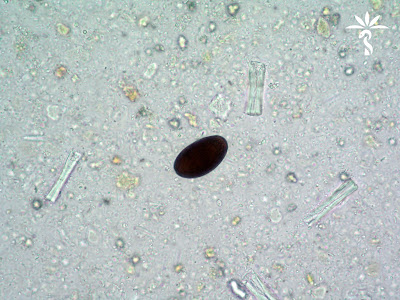This month's case from Idzi Potters and the Institute of Tropical Medicine, Antwerp, features a stool specimen from a traveler returning from Iran. No clinical data is available, nor any additional lab-results. The following photos show structures that were found in the patient’s stools. The average size of these objects is 42 x 25 µm. Click on the images to enlarge.
What is the diagnosis (& possible clinical relevance)?
Monday, December 3, 2018
Subscribe to:
Post Comments (Atom)






9 comments:
Dicrocoelium dendriticum
They look like Dicrocoelium dendriticum eggs. It would be necessary to make sure if it is a false parasitism or a real case, given the biological peculiarities of this species.
Luis.
From the pictures, the eggs seem to be operculated. The angle of photography shows a slightly flatened side. These eggs appear brown in color, possibly resulting from bile pigment. The measurements are compatible with those of Dicrocoelium dendriticum. From CDC/DPDX: "light infections are asymptomatic. Heavier infections can result in cholecystitis, liver abcesses and upper abdominal pain".
Idzi: Merci beaucoup pour nous donner ces cas bien educatifs. On ne les rencontre pas souvent ici malgre qu'il y a un influx d'immigrants.
Florida Fan
Given the usual geographical distribution of the small liver fluke (Dicrocoelium dendriticum) in the Old World (Europe), and the rarity of this infection in adults, the hypothesis of cooked eggs in transit without clinical significance and non-infective seems to me to be the first thing to discuss. In this case, if the patient come back and the stool examination could be repeated, it would be negative.
It look like dicrocoelium dendriticum but stool examination should be repeated
So, there is this old story, or so I am told, about ants getting ready for the winter. They gathered up food stores all day, including slime balls produced by snails. Then along came a lazy grasshopper, which had spent the summer playing and not preparing for the winter. When the winter came, the grasshopper begged the ants for something to eat, even a slime ball!!! The ants refused. In the Spring, the ants had an insatiable urge to climb to the tops of blades of grass and ended up getting eaten by cattle and sheep! The grasshopper did not get eaten by the livestock? The moral of this story? Play all day and you are guaranteed not to become cow chow! Not really, but maybe Bobbi's answer to the case will shed light on this fable, or my rendition of it... ;-)
I always do enjoy reading Blaine’s peculiar view on things!
;-)
Indeed this one is a nice example of how parasites can change one host’s behavior to facilitate ending up in their next host...
Bravo Blaine. Wonderful parable.The life cycle of Dicrocoelium dendriticum is a real testament to the powers of behavioral diversity combined with evolution.
D.d is beautiful critter. So flat you can clearly see all it's major organ systems without the benefit of stains. So thin it is commonly called the Lancet fluke. These dimensions allow D.d to dwell within the biliary ducts where they can allow normal bile flow in small numbers or block the flow with greater numbers. They can be expressed by the hundreds out of the ducts. An easy treasure trove for biological supply houses.
This is not true for other species of herbivore liver flukes. Our local fluke, Fascioloides magna lives in egg sized. tough, fiberous cysts within the liver tissue. The cysts are filled with a dark maroon, goopy, smelly, slug consisting of fluke waste (puke) and fluke eggs. The fluke is as large as a small leaf and can only be collected by cutting the liver like a loaf of bread until you hit a cyst
Nothing to do with D.d
Just watched rerun of the movie "Alien", my favorite parasite movie.
Am always impressed with Commander Ripley's antiparasitic efficacy
Post a Comment